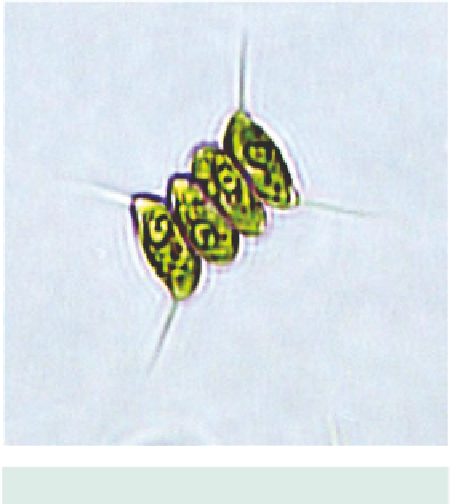Environmental Engineering Reference
In-Depth Information
touching and forming definite clusters
.........................
Pleurococcus
Pleurococcus
(synonyms
Apatococcus
and
Desmococcus
) has cells (5-20 μm
wide) which are globular to angular and
usually in dense masses, sometimes form-
ing short filaments. The chloroplast is
large, parietal and lobed, with or without
a pyrenoid. Frequently found on tree bark,
fences and other aerial habitats. Chloro-
phyta. Plate XIII.
(b) Cells aquatic, oval or triangular in
shape,usuallyingroupsoffoursometimes
sticking to each other by means of a thin
mucilaginous surround . .....
Crucigenia
15 μm
Crucigenia
colonies consist of four cells
arranged in a cross so that a gap may be
present at the colony centre. Cells have a
parietal chloroplast with a small pyrenoid,
5-10 μm wide. Frequent in the plankton.
Chlorophyta. Plate XIII.
Figure 4.50
Scenedesmus
. Four-cell colony. This
species (
S. opoliensis
) has two prominent spines on each
outer cell.
(b) Cells without spines or projections
..................................
105
106
(68) (a) Cells with flagella, motile .......
107
104
(103) (a) Cells spherical, in groups of 4-16,
each bearing long tapering spines (many
times as long as the cell) . .
Micractinium
(b) Cells without flagella, non-
motile . ...........................
126
NB.
Some groups of diatoms are able to
move with a gliding action and do not have
flagella.
(see also key No. 96)
(b) Cells angular and usually in groups of
four but may be solitary. Spines usually
very fine and short (not more than 2 times
celldiameter)...............
Tetrastrum
107
(106) (a) Cells covered with delicate scales
bearing long bristles or spines which, at a
first glance, resemble many flagella but are
incapable of movement. One single flag-
ellum occurs at the apical end and is used
for locomotion. . . . ........
Mallomonas
Cells of
Tetrastrum
are 3-7 μmwide
(excluding the spines) with a cup-shaped
chloroplast with or without a pyrenoid.
Planktonic but not usually abundant.
Chlorophyta. Plate XIII.
Mallomonas
is unicellular and free swim-
ming. Its cells are an elongated oval shape,
8-100 μm long and up to 30 μm wide.
They are covered with numerous fine
105
(103) (a) Cells growing on a damp substrate,
aerial, globular or angular in shape when

Search WWH ::

Custom Search